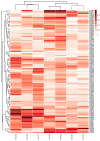Comparison of Policosanol Profiles of the Sprouts of Wheat Mutant Lines and the Effect of Differential LED Lights on Selected Lines
- PMID: 37836116
- PMCID: PMC10574449
- DOI: 10.3390/plants12193377
Comparison of Policosanol Profiles of the Sprouts of Wheat Mutant Lines and the Effect of Differential LED Lights on Selected Lines
Abstract
Policosanols (PCs) are long-chain linear aliphatic alcohols that are present in the primary leaves of cereal crops, such as barley and wheat, sugar cane wax, and beeswax. PCs have been used as a nutraceutical for improving hyperlipidemia and hypercholesterolemia. However, the PC content in mutant wheat lines has not been investigated. To select highly functional wheat sprouts with a high content of PCs in wheat mutant lines developed via gamma-irradiated mutation breeding, we cultivated the sprouts of wheat mutant lines in a growth chamber with white LED light (6000 K) and analyzed the PC content in these samples using GC-MS. We studied the PC content in 91 wheat sprout samples: the original variety (Woori-mil × D-7; WS01), commercially available cv. Geumgang (WS87) and cv. Cheongwoo (WS91), and mutant lines (WS02-WS86 and WS88-WS90) developed from WS01 and WS87. Compared to WS01, 18 mutant lines exhibited a high total PC content (506.08-873.24 mg/100 g dry weight). Among them, the top 10 mutant lines were evaluated for their PC production after cultivating under blue (440 nm), green (520 nm), and red (660 nm) LED light irradiation; however, these colored LED lights reduced the total PC production by 35.8-49.7%, suggesting that the cultivation with white LED lights was more efficient in promoting PCs' yield, compared to different LED lights. Therefore, our findings show the potential of radiation-bred wheat varieties as functional foods against hyperlipidemia and obesity and the optimal light conditions for high PC production.
Keywords: GC-MS; LED light; Triticum aestivum; policosanol; wheat.
Conflict of interest statement
The authors declare no conflict of interest.
Figures




References
-
- Han A., Hong M.J., Nam B., Kim B., Park H.H., Baek I., Kil Y., Nam J., Jin C.H., Kim J. Comparison of Flavonoid Profiles in Sprouts of Radiation Breeding Wheat Lines (Triticum aestivum L.) Agronomy. 2020;10:1489. doi: 10.3390/agronomy10101489. - DOI
Grants and funding
LinkOut - more resources
Full Text Sources
Miscellaneous

